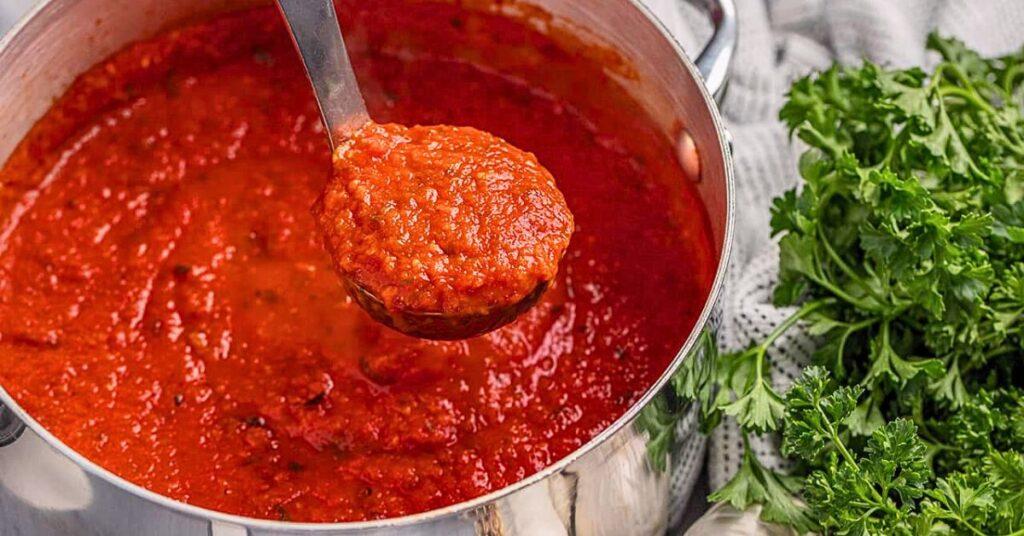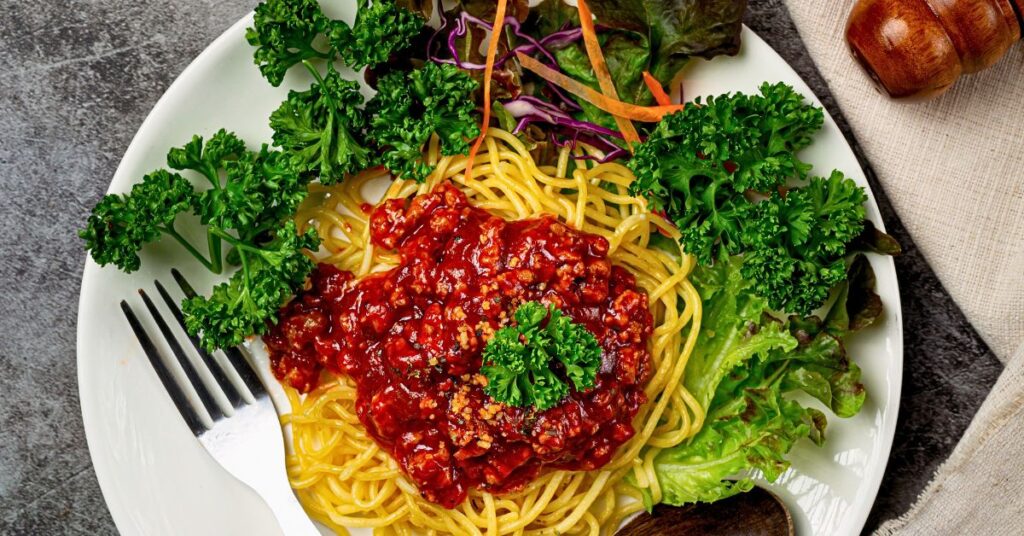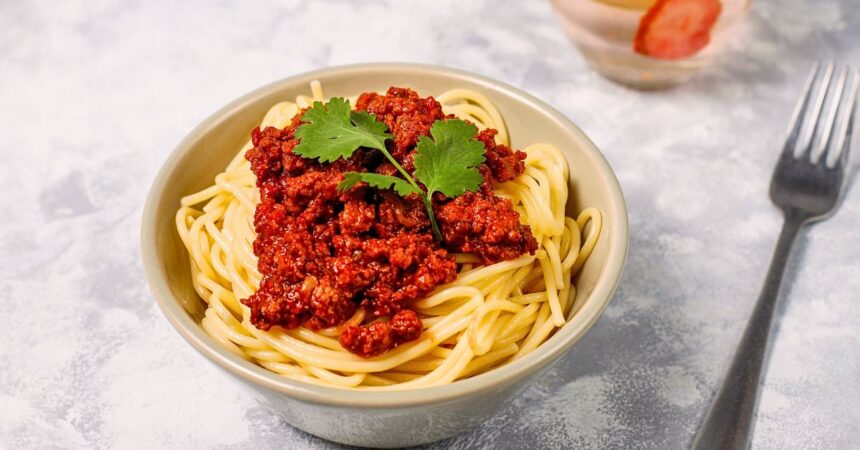The Mediterranean diet has become increasingly popular due to its emphasis on whole, fresh, and natural ingredients. One of the most versatile dishes in Mediterranean cuisine is a rich, flavorful spaghetti sauce that doesn’t rely on meat to pack a punch.
In this recipe, we’ll show you how to create an unforgettable Mediterranean spaghetti sauce without meat that’s perfect for vegetarians, vegans, or anyone looking to embrace a healthier lifestyle without sacrificing taste.
Ingredients for the Perfect Mediterranean Spaghetti Sauce

To craft an authentic Mediterranean sauce, we focus on fresh, high-quality ingredients that blend together harmoniously. Here’s what you’ll need:
- Extra Virgin Olive Oil – 4 tablespoons
- Garlic – 4-5 cloves, minced
- Onion – 1 medium, finely chopped
- Crushed Tomatoes – 2 cans (28 oz each), preferably San Marzano for added sweetness
- Tomato Paste – 2 tablespoons
- Red Bell Pepper – 1, diced
- Kalamata Olives – ½ cup, pitted and halved
- Capers – 2 tablespoons, rinsed
- Sun-dried Tomatoes – ½ cup, chopped
- Fresh Basil – ½ cup, chopped
- Oregano – 2 teaspoons, dried
- Red Pepper Flakes – ½ teaspoon (optional, for a bit of heat)
- Sugar – 1 teaspoon (optional, to balance acidity)
- Salt and Pepper – to taste
- Fresh Parsley – for garnish
These ingredients form the backbone of the sauce, creating a robust and aromatic flavor that’s truly Mediterranean.
Step-by-Step Directions for Mediterranean Spaghetti Sauce

1. Heat the Olive Oil
Start by heating the extra virgin olive oil in a large skillet over medium heat. This oil is the heart of Mediterranean cooking, and it provides a rich, smooth base for the sauce. Once the oil is hot, add the minced garlic and sauté until golden brown. Be careful not to burn the garlic as it can turn bitter.
2. Sauté the Onion and Bell Pepper
Next, add the finely chopped onion and diced red bell pepper. Stir occasionally and cook for about 5-7 minutes until they soften and become translucent. The sweetness of the onion and the bell pepper adds a depth of flavor that compensates for the absence of meat.
3. Add Tomato Paste for Depth
Once the onions and peppers have softened, stir in the tomato paste. Allow it to cook for 2-3 minutes, stirring constantly. The tomato paste adds a concentrated tomato flavor and gives the sauce a thicker, more luxurious texture.
4. Incorporate the Crushed Tomatoes
Now it’s time to add the crushed tomatoes. These provide the main body of the sauce. If possible, choose San Marzano tomatoes, which are known for their sweetness and low acidity. Bring the mixture to a simmer and reduce the heat to low, allowing the flavors to meld together.
5. Add the Mediterranean Elements: Olives, Capers, and Sun-dried Tomatoes
Here’s where the Mediterranean magic truly happens. Stir in the Kalamata olives, capers, and sun-dried tomatoes. These ingredients are quintessentially Mediterranean, adding briny and tangy notes to the sauce.
The olives bring in a rich, salty taste, while the capers add a sharp tang that cuts through the sweetness of the tomatoes. The sun-dried tomatoes contribute a concentrated burst of umami flavor.
6. Season the Sauce
Add the dried oregano and red pepper flakes (if you like a bit of heat). Season the sauce with salt and freshly ground black pepper, adjusting to taste. Let the sauce simmer uncovered for 20-25 minutes, stirring occasionally to prevent sticking.
If the sauce seems too thick, you can thin it out with a little water or vegetable broth.
7. Fresh Herbs for Brightness
Once the sauce has reduced and thickened to your liking, stir in the fresh basil. The basil should be added towards the end to maintain its vibrant flavor. The combination of basil and oregano gives the sauce an earthy, herbaceous quality that is emblematic of Mediterranean cuisine.
8. Finish with a Touch of Sweetness
If your sauce tastes a little too acidic, add a teaspoon of sugar to balance the flavors. This step is optional, but it can help if the tomatoes you used are on the tart side. Adjust the seasoning as necessary before turning off the heat.
Serving Suggestions for Mediterranean Spaghetti Sauce

This Mediterranean spaghetti sauce is incredibly versatile and can be used in many dishes. Here are some ways to enjoy it:
1. Classic Pasta Dish
Toss the sauce with al dente spaghetti or any pasta of your choice. Top with freshly grated Parmesan cheese or a plant-based alternative for a full meal. Garnish with fresh parsley for added color and freshness.
2. Baked Dishes
This sauce is perfect for baked dishes like eggplant parmesan or vegetarian lasagna. The bold flavors of the olives, capers, and sun-dried tomatoes stand out beautifully in baked casseroles.
3. As a Base for Mediterranean Pizza
Spread the sauce over a pizza crust, top with mozzarella, feta, or goat cheese, and your favorite vegetables like artichoke hearts or zucchini for a Mediterranean-style pizza that’s full of flavor.
4. Dipping Sauce
Serve this sauce as a dipping accompaniment for crusty bread or pita. Add a sprinkle of crushed red pepper flakes for a spicy kick or drizzle with a little more olive oil for a rich, decadent dip.
Why Choose a No-Meat Mediterranean Sauce?
Choosing a meat-free spaghetti sauce has numerous benefits, especially when adopting the Mediterranean diet. Here are some reasons why this recipe is a great choice:
1. Health Benefits
This sauce is packed with antioxidants from the tomatoes and herbs, healthy fats from the olive oil, and fiber from the vegetables and olives. Unlike meat-based sauces, this one is naturally lower in saturated fat and cholesterol, making it a heart-healthy option.
2. Plant-Based and Vegan Friendly
By skipping meat and any animal-derived ingredients, this sauce is perfect for vegans and vegetarians alike. You get all the flavor of a traditional Mediterranean sauce without the need for animal protein.
3. Burst of Mediterranean Flavors
The combination of briny olives, capers, and sun-dried tomatoes creates a flavor profile that is both rich and refreshing. It’s a perfect example of how Mediterranean cooking celebrates simple, fresh ingredients to create complex, satisfying dishes.

Storing and Freezing Your Mediterranean Sauce
This sauce can be made ahead and stored for convenience. Here’s how:
1. Refrigeration
Store the sauce in an airtight container in the refrigerator for up to 5 days. The flavors will deepen as the sauce sits, making it even more delicious the next day.
2. Freezing
To freeze, let the sauce cool completely, then transfer it to a freezer-safe container. It will keep for up to 3 months. When you’re ready to use it, simply thaw overnight in the fridge and reheat on the stove.
Conclusion
This Mediterranean spaghetti sauce recipe without meat showcases how you can enjoy a rich, hearty sauce without the need for animal products.
With a vibrant combination of fresh vegetables, briny olives, sun-dried tomatoes, and aromatic herbs, this sauce is full of Mediterranean flavors that will leave you craving more.
Whether you’re embracing a plant-based lifestyle or simply want to try something new, this recipe is a must-have in your kitchen repertoire.
Frequently Asked Questions
Can I substitute fresh tomatoes for canned crushed tomatoes?
Yes, you can definitely use fresh tomatoes instead of canned. Opt for Roma or San Marzano varieties for their rich flavor and low water content. Simply blanch, peel, and crush the tomatoes before adding them to the sauce. You may need to cook the sauce a bit longer to achieve the same thickness as using canned tomatoes.
Is this sauce vegan-friendly?
Absolutely! This Mediterranean spaghetti sauce recipe is completely vegan as it contains no animal products. The richness of flavor comes from the olive oil, herbs, and plant-based ingredients like Kalamata olives and capers.
What type of pasta works best with this Mediterranean sauce?
This sauce pairs well with all kinds of pasta, but spaghetti, linguine, or fettuccine are great choices due to their ability to hold the sauce. For a healthier option, you can use whole wheat pasta or even zucchini noodles.
How can I adjust the sauce if it’s too acidic?
If the sauce tastes too acidic, you can add a teaspoon of sugar to balance the acidity. You can also stir in a small amount of carrot puree for natural sweetness, which is a common technique in Mediterranean cooking.
Can I add other vegetables to this sauce?
Definitely! This recipe is versatile, so you can add vegetables like zucchini, eggplant, mushrooms, or spinach. Simply sauté them along with the onions and bell peppers to incorporate them into the sauce.
Is it possible to add protein to the sauce?
If you’re looking to add some protein while keeping the sauce vegetarian, try incorporating cannellini beans, chickpeas, or even lentils. For a non-vegetarian option, you could add grilled chicken, shrimp, or fish while maintaining the Mediterranean flavors.
What are some ways to serve this sauce beyond pasta?
This sauce is incredibly versatile. You can use it as a base for pizza, a topping for grilled vegetables, or even a sauce for baked dishes like eggplant parmesan or lasagna. It also works well as a dipping sauce for crusty bread or served over grains like quinoa or farro.
Can I make this sauce spicy?
Yes, to give the sauce a bit of heat, simply increase the amount of red pepper flakes or add a small chopped chili pepper when sautéing the garlic and onions. You can adjust the spiciness based on your preference.
What can I use instead of capers if I don’t have any on hand?
If you don’t have capers, you can substitute them with something else that offers a briny, tangy flavor. Green olives, pickled jalapeños, or even a splash of vinegar can mimic the sharp taste that capers provide.
Can I omit the sun-dried tomatoes?
Yes, but keep in mind that sun-dried tomatoes add a rich, umami flavor and a touch of sweetness that enhances the sauce. If you omit them, you may want to add an extra tablespoon of tomato paste or an additional pinch of sugar to balance the flavors.

Nice Information keep it up 🫶😊
The food was fantastic dish was expertly prepared and full of amazing flavors. 👏